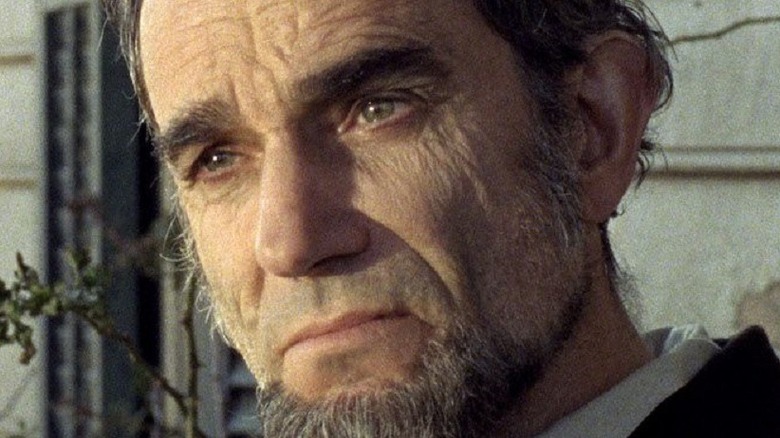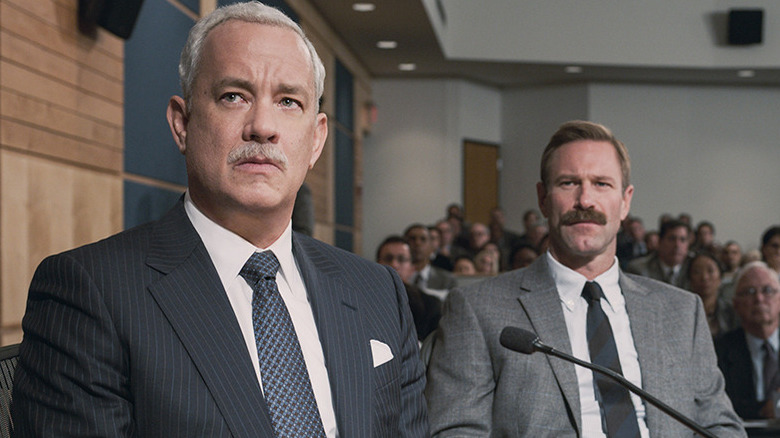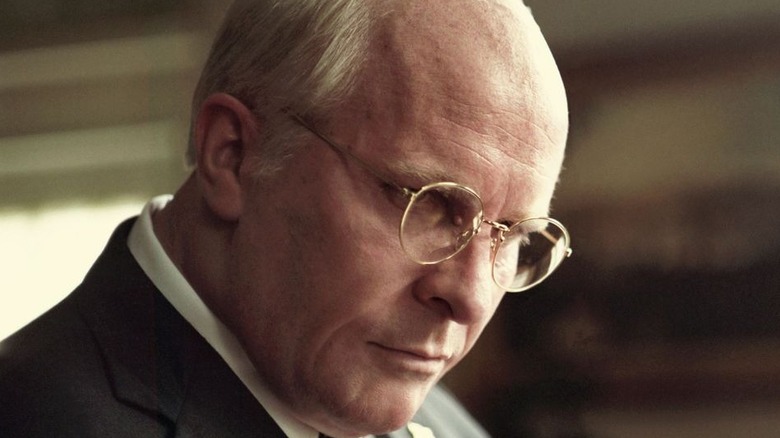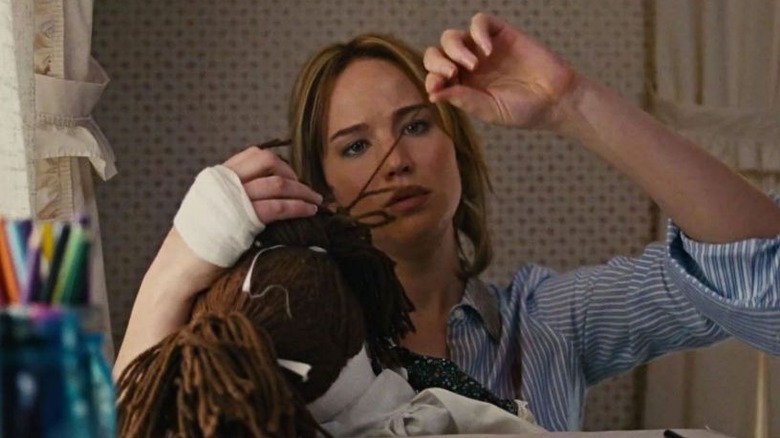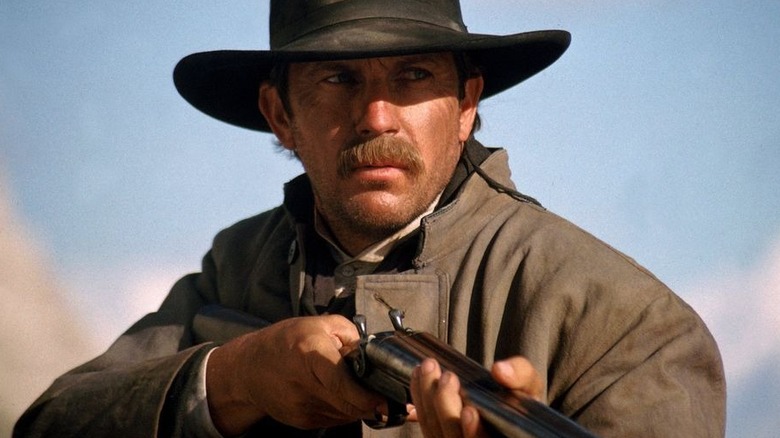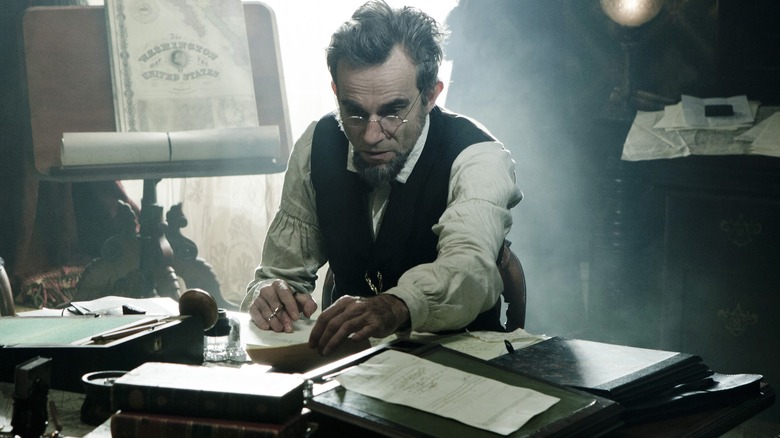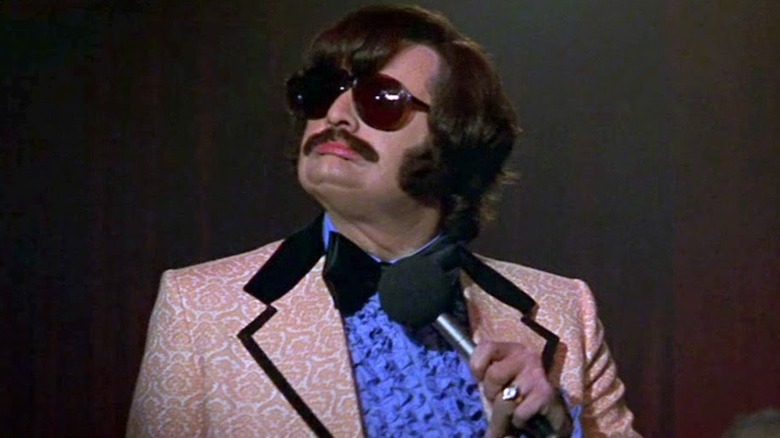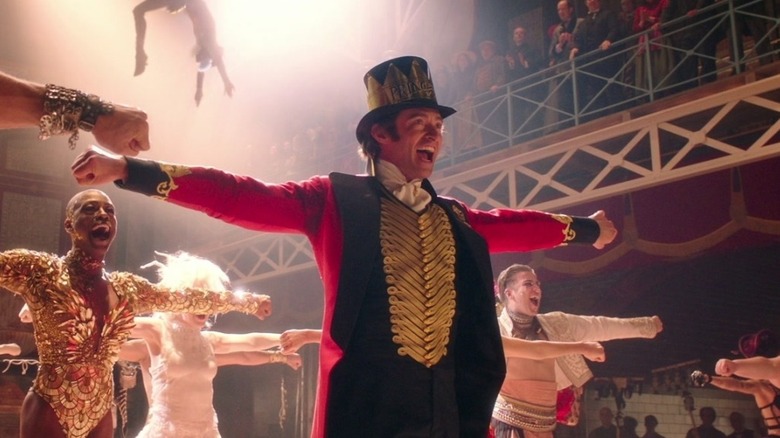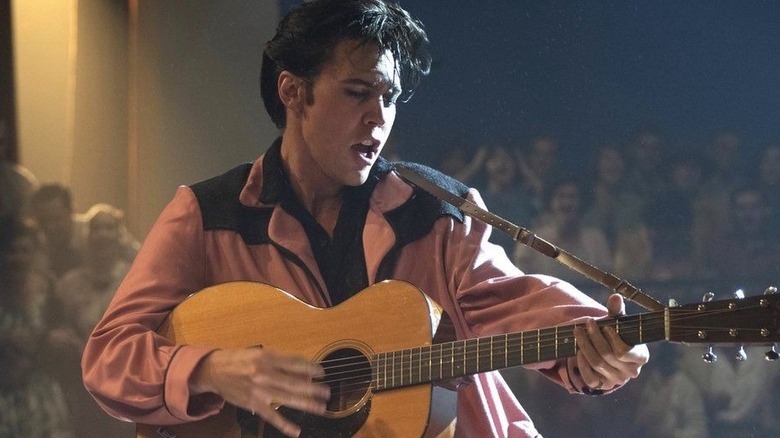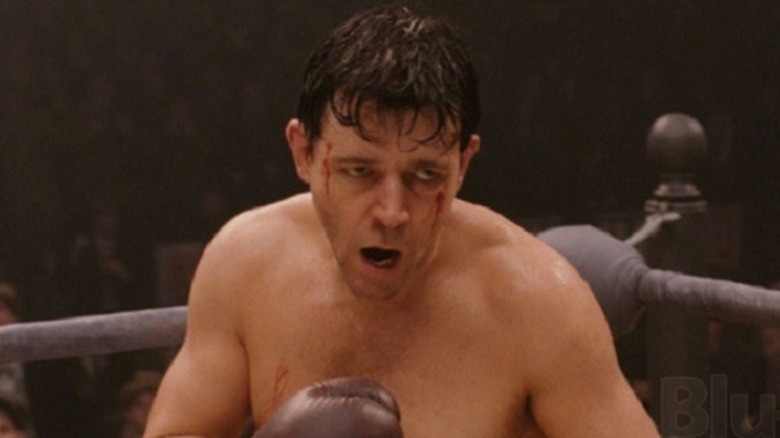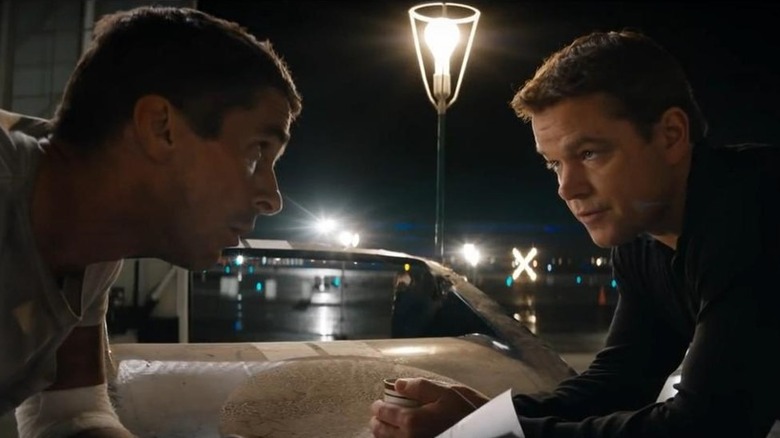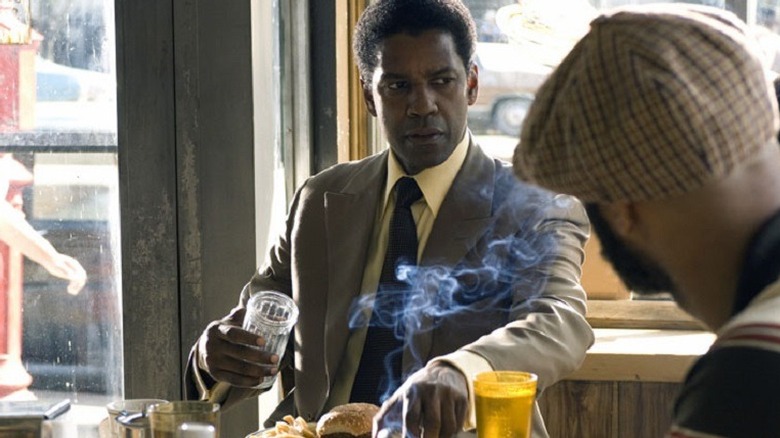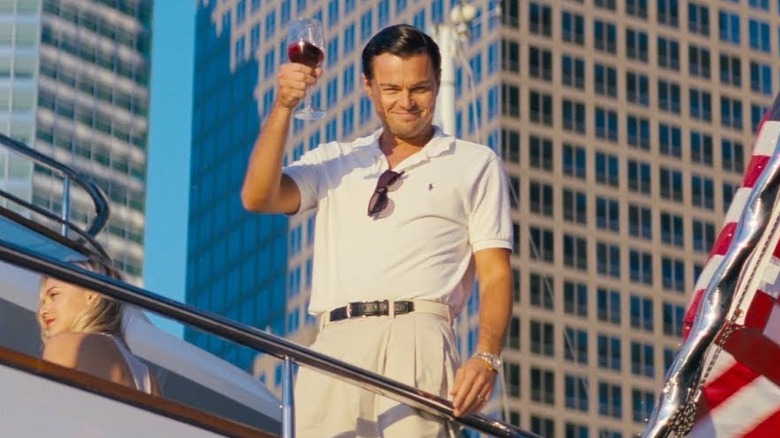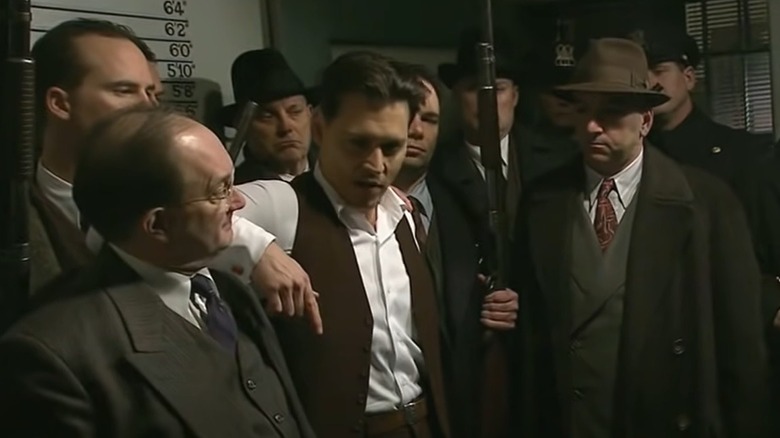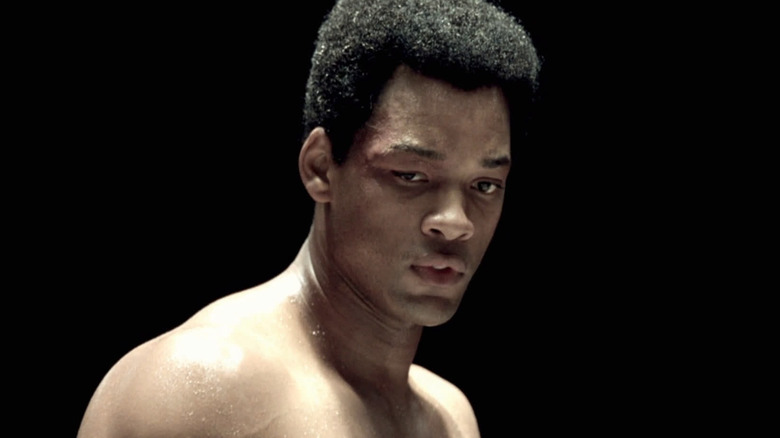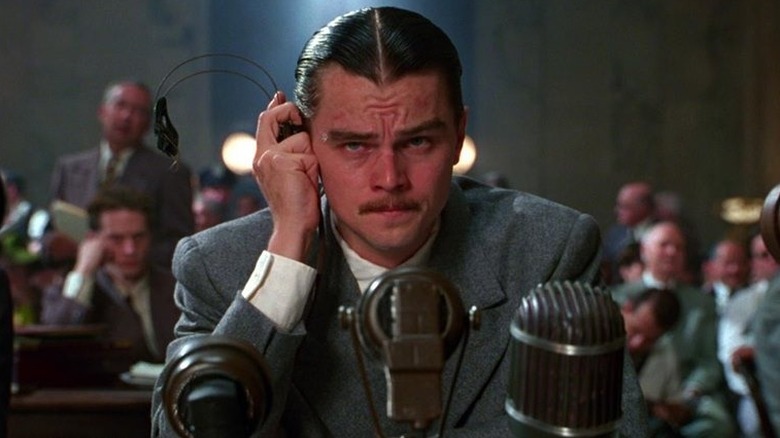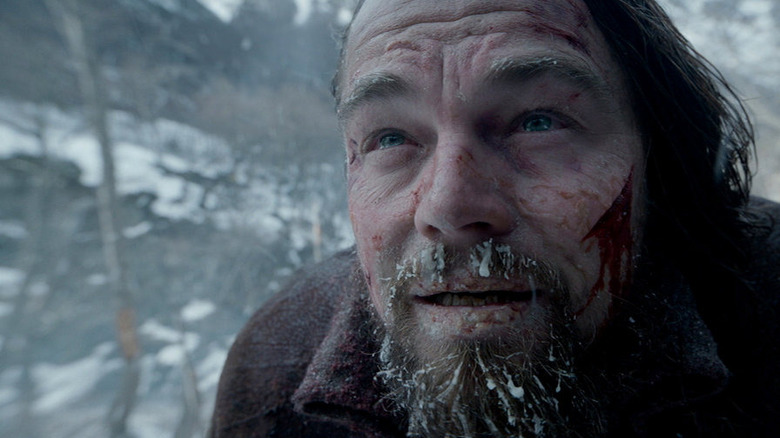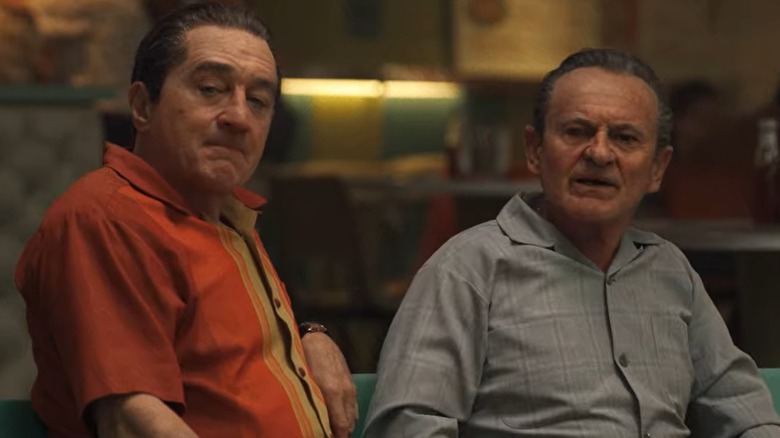The Most Expensive Biopics Of All Time
Biopics allow us to either learn about someone we're not familiar with, or learn more about someone we are, and in a slightly more exciting manner than a documentary or a book. Sure, many biopics play a bit fast and loose with the facts in order to make the person or their story a little more engaging. In some cases, that has even resulted in the topic of said biopic speaking out against the film for just how much it changed their story. But at the end of the day, the average moviegoer just wants to watch an interesting movie, rather than one that is 100% "accurate."
A biopic might seem like a fairly straightforward kind of movie, one that doesn't involve a massive production budget. And while that is the case for most, there are some biopics that cost a sizable chunk of money to make — some even exceeding the $100 million mark. It's those pricier biopics that this feature is going to address, as well as why their budgets ballooned the way that they did.
This list will primarily look at biopics that focus on just one or a select few people, rather than an entire sports team or military battalion. In addition, biopics that get into "historical epic" territory — "Alexander," Braveheart," "Lawrence of Arabia," et al — were not considered, as those not only typically have large budgets but they just tend to have a different feel than the average character-driven biopic. All budget estimates used for this feature are courtesy of Box Office Mojo.
Sully ($60 million)
As a director, Clint Eastwood has long shown an interest in making movies about real people and events. "J. Edgar," "Flags of Our Fathers," "Invictus," and "Midnight in the Garden of Good and Evil" are but a few of the films he has made that dramatize true stories. With 2016's "Sully," he tackled a story that had only just occurred seven years prior — the emergency landing by the titular pilot of a commercial airplane that saved 155 lives.
Needless to say, a lot of the movie's considerable budget was spent on the crash sequence, as well as the subsequent escape scenes taking place on the Hudson River. Since the movie was shot for the IMAX format, everything had to look all the more impressive and be able to hold up to the scrutiny of audiences seeing it on enormous IMAX screens. In addition, a building in Atlanta was converted to look like a New York City hotel for filming purposes, which significantly added to the cost of the production (per Film L.A. Inc).
It all paid off, as "Sully" not only grossed nearly $250 million globally but also set a new record for IMAX opening weekend of a non-3D movie (per Deadline).
Vice ($60 million)
Considering both of the major Hollywood films that have depicted the George W. Bush presidency — 2008's "W" and 2018's "Vice" — have leaned into comedy, it's pretty clear what some filmmakers feel about it. And Adam McKay's "Vice" takes it even further than "W" did, delivering a dark, biting comedy satire that pulls very few punches in its depiction of its targets — especially former vice president Cheney.
Paramount was initially going to produce "Vice," but they weren't too thrilled about the movie's $60 million price tag. So it moved to Annapurna Pictures (per Bomb Report), who had more faith in McKay's track record following his previous based-on-a-true-story political comedy "The Big Short." It's unclear exactly why "Vice" was so costly to make, but the likely culprits were its large cast of A-listers and the incredible make-up/prosthetics work done on Christian Bale that rendered him unrecognizable as Cheney.
It didn't pay off, however, as the movie was barely able to break even at the box office (per Box Office Mojo). Still, "Vice" was nominated for eight Academy Awards, with the make-up team taking home a well-deserved win.
Joy ($60 million)
After a handful of films that were completely fictional stories, filmmaker David O. Russell first ventured into the world of biopics with 2010's acclaimed "The Fighter." Perhaps due to the fact that the movie earned Russell his first Oscar, Golden Globe, and Directors Guild of America nominations, he would end up making more movies based on real people and true stories. Next was 2013's "American Hustle," and that was followed by "Joy" two years later.
Based on the remarkable true story of Joy Mangano — inventor of the Miracle Mop, an eventual billion-dollar product (per Forbes) — "Joy" follows the ups and downs of its titular entrepreneur as she refuses to give up despite multiple setbacks that would've made most people throw in the towel. Jennifer Lawrence gives a stellar, Golden Globe-winning performance in the title role, with a strong supporting cast that includes Robert De Niro and Bradley Cooper. The hefty $60 million price tag might not have gone to any big action set pieces or special effects, but Russell does know how to make a really great-looking film — and sometimes it takes a lot of money to make that happen.
Wyatt Earp ($63 million)
Kevin Costner has been one of the most prolific stars and filmmakers of Westerns in the last few decades, and that has even extended to playing real-life figures from the American West. Such is the case for 1994's "Wyatt Earp," in which Costner plays the legendary marshal who was part of the fabled gunfight at the O.K. Corral. Directed and co-written by Lawrence Kasdan, the movie has an incredible ensemble cast that also includes Gene Hackman, Dennis Quaid, Bill Pullman, Catherine O'Hara, Mark Harmon, and many others.
It's not hard to see why an epic Western would require a covered wagon-sized pile of cash to produce, and the budget of "Wyatt Earp" was well spent on not only the cast but gorgeous cinematography and thrilling action scenes. That said, audiences didn't show up for the movie, and critics weren't especially kind to it. It even made several critics' lists of the worst films of the year, including Peter Travers of Rolling Stone, who placed it at #2 on his list. Still, most critics at least conceded that the movie looked fantastic, and Owen Roizman would go on to earn an Oscar nomination for Best Cinematography.
Lincoln ($65 million)
Daniel Day-Lewis doesn't so much play characters as he becomes them, and his disappearing into Abraham Lincoln was no exception. In the Steven Spielberg-directed biopic "Lincoln," Day-Lewis earned his third Best Actor Oscar for a performance that noted Lincoln historian Allen Guelzo called "so close to [his] own mental image of what Lincoln must have been like." Also due for high praise are Sally Field as Mary Todd Lincoln, Joseph Gordon-Levitt as Robert Todd Lincoln, and Tommy Lee Jones as Thaddeus Stevens.
Spielberg isn't exactly known for low-key filmmaking — and to that end, every frame of "Lincoln" is lavish, beautiful, and incredibly expensive-looking. If anything, it's almost surprising that such a lush historical drama was made for only $65 million. But the movie could've cost twice that much and still earned a tidy profit, as "Lincoln" went on to gross a little over $275 million worldwide.
It may have lost the Academy Award for Best Picture to "Argo," but "Lincoln" was still declared the best film of 2012 by at least seven major outlets, including Entertainment Weekly, The New York Times, The New Yorker, the Village Voice, and The San Francisco Chronicle (per Metacritic).
Man on the Moon ($82 million)
The privilege of getting to play subversive comedian Andy Kaufman in the biopic "Man on the Moon" was one that some of Hollywood's biggest names fought for — so much so that they were willing to kick it old school and actually audition, despite being well beyond the auditioning phase of their career. Among those who did so were Edward Norton, Kevin Spacey, Hank Azaria, and John Cusack (per Entertainment Weekly). But it was ultimately Jim Carrey who got the role, with an audition that was reportedly miles ahead of everyone else's.
Indeed, Carrey's portrayal of Kaufman is borderline eerie at times — not just in replicating Kaufman's kooky characters and over-the-top stage antics but also in showing him in low-key, private moments. While stories about how actors went so method for a role that they stayed in character throughout a film's production can seem pretentious, given Kaufman's history with messing with both his audiences and even his closest friends, it actually fits with his vibe that Carrey would "become" Kaufman to an extreme degree during the shoot.
Carrey, who was commanding $20 million-per-movie paychecks at that point in his career, was even willing to take a pay cut to play the role (per EW). Which means that the only explanation as to why "Man on the Moon" was so costly is in re-building the various TV show sets Kaufman had filmed on, and the impressive wardrobe and make-up work.
The Greatest Showman ($84 million)
Not all biopics are accurate. In fact, some more or less deliberately gloss over a person's life and the story surrounding it for the sake of a feel-good, crowd-pleasing movie experience. Such is the case with "The Greatest Showman" — which paints a warm, positive, and generous portrait of a man who, by most accounts, was the opposite of all of those traits. Hugh Jackman plays a very fictionalized version of entertainment businessman P.T. Barnum in the story of his co-creation of the Barnum & Bailey Circus.
If you can look past how inaccurate the movie is and how poorly treated most of the real-life figures were, "The Greatest Showman" is a really fun musical that hearkens back to the golden age of the genre. Jackman — along with co-stars Michelle Williams, Zac Efron, Zendaya, Rebecca Ferguson, et al — belt out memorable songs that you'll be singing for weeks, accompanied by lush, complexly-choreographed set pieces. And most of the numbers happen on expansive, gorgeous sets that take place on rooftops, in circus tents, and down period-accurate alleyways.
At the end of the day, "The Greatest Showman" might not tell an honest story, but the quality of its music and production values sure do make the lie go down smoothly.
Elvis ($85 million)
Filmmaker Baz Luhrmann doesn't seem to know the meaning of the word "budget." For a time, his Netflix series "The Get Down" was the most expensive the streaming service had ever commissioned (per Vanity Fair) — and that was just a show about some kids trying to make it as musicians during the early days of hip hop in 1970s New York City. Imagine what he would spend on a biopic about Elvis Presley, a musician with one of the most famously extravagant careers and lifestyles in music history.
There's no need to imagine it, as Luhrmann's "Elvis" ended up needing a whopping $85 million to swivel its hips into theaters. It's actually fairly subdued compared to "Moulin Rouge" or "Romeo + Juliet," but that doesn't mean that it's not still ridiculously stylized and completely over-the-top in the way that only a Luhrmann production can be. As for whether it was worth it, the overall consensus is pretty positive.
Cinderella Man ($88 million)
Russell Crowe has played several real-life figures in his career, and he got Oscar nominations for two of them — John Nash of "A Beautiful Mind," and Dr. Jeffrey Wigand of "The Insider." He would reteam with "A Beautiful Mind" director Ron Howard to make another biopic, "Cinderella Man," about boxer James J. Braddock. While reviews were largely positive, the movie underperformed at the box office — at least in comparison to its rather pricey $88 million budget.
As for why a boxing biopic would cost so much money to make, blame the big names involved and their associated paychecks. According to Bomb Report, stars Crowe and Renee Zellweger, along with Howard and producer Brian Grazer, all not only got big paydays up front but also got even more cash thanks to various participation deals. It's not known just how much of that $88 million went straight into the pockets of those four, but it was certainly a sizable chunk given that "Cinderella Man" doesn't look or feel like a movie that needed more than $30 or $40 million to make.
The fact that Zellweger reportedly demanded a body double just because she couldn't stand how smelly Crowe was certainly didn't help keep costs down, either.
Patch Adams ($90 million)
Taking the idea of "laughter is the best medicine" literally, the real life Dr. Hunter "Patch" Adams gained notoriety for wearing clown attire around sick patients — children in particular — in an effort to cheer them up and inspire a positive outlook as they battled whatever diagnosis or disease they were facing. In bringing such a character to life on the big screen, Robin Williams seems like an obvious choice. He had already portrayed a character who was at least based on a real doctor in "Awakenings," so he just needed to bring the funny in "Patch Adams." And, as we all know, that wasn't something that Williams ever failed to do on screen.
The real Dr. Adams had his issues with the film, something he wasn't shy about discussing (via Newsweek). Critics also hated it, though it was beloved by audiences. Sandwiched between more serious roles in "Good Will Hunting" and "Jakob the Liar," "Patch Adams" felt like the return of the sillier, more family-friendly Williams that fans had been missing since the likes of "Mrs. Doubtfire" and "Aladdin." As for the big budget, that likely comes from the fact that the movie was shot in three locations across two states, in addition to constructing a replica of the university diner from scratch (per Citizen Times).
It certainly didn't all go in Williams' pocket, as he reportedly only made $2 million to star in the film (per Page Six).
Ford v Ferrari ($98 million)
There are no shortage of great racing movies, be they based on a true story feature Vin Diesel talking about "family" a lot. There is a case to be made that the best non-documentary racing movie ever made is 2019's "Ford v Ferrari," which tells the story of Henry Ford and Lee Iacocca trying to create a car that could end Ferrari's reign in the Le Mans race. Starring Christian Bale and Matt Damon as one current and one retired driver, respectively, working on the Ford side of things, the film nails both the human drama and the racing action flawlessly.
Director James Mangold already had experience with both biopics ("Walk the Line") and films that skillfully balance action and drama ("Logan"), and "Ford vs Ferrari" feels like his masterpiece in that regard. The nearly $100 million price tag was obviously spent largely on the racing scenes, but the entire movie just has that new car shine to it even off the track. There have been excellent racing drama movies and excellent racing action movies, but typically, they lean much more heavily one way or another. "Ford v Ferrari" might be the only move that does both equally well and doesn't hold back on either.
American Gangster ($100 million)
"American Gangster" had years of development struggles before the finished version was finally released in the fall of 2007, as documented by Entertainment Weekly. While director Ridley Scott was the first to express interest, the project's planned start date conflicted with his schedule and Brian De Palma entered the fray. Next, it was going to be a re-teaming of Anthony Fuqua and Denzel Washington — who worked together on "Training Day" — before Fuqua was to be replaced by Peter Berg following creative differences with the studio. Benicio Del Toro was to be Washington's co-lead, but that role was eventually given to Russell Crowe instead. For a time, Washington himself was even out and Will Smith was to take his place.
Sooner or later, the dust finally settled, finding Washington back as the star with Ridley Scott back in the director's chair. The delays were costly, including having to pay Del Toro $5 million for just having been attached to the film despite not appearing in it. But the movie definitely looks and feels like it could've been a $100 million production even if things had gone smoothly — it's a stylish crime epic that earned critical praise and still made a nice profit even with its exorbitant price tag.
The Wolf of Wall Street ($100 million)
Leonardo DiCaprio has been Martin Scorsese's guy for a long time now, with them each doing some of the best work of their respective careers while working together. And Scorsese's love of telling stories about the rise and fall of powerful people and DiCaprio's aptitude at playing real figures collided in spectacular fashion for the epic biopic "The Wolf of Wall Street." Based on Jordan Belfort's memoir about his time as a Wall Street stockbroker, the movie deliberately mirrors the excesses of Belfort's life and career by also being a movie of excesses — not only in its scenes of graphic intimacy and drug use but in setting a new record for the most swearing in a movie (per Guinness World Records).
Considering that the real Mr. Belfort probably could've funded the movie himself from his own personal bank account at the height of his career, $100 million doesn't seem like all that much. But it's one of only a handful of biopics to break a nine-figure budget, and definitely one of Scorsese's most expensive movies. Given that it's his highest-grossing movie ever worldwide, it seems like it all paid off.
Public Enemies ($100 million)
Whether it's all the action scenes, the period-appropriate costuming, having to fill the streets with old timey cars, or just having to make the movie look like it takes place during the Great Depression, movies about the gangster era are typically pretty costly to produce. This is most certainly true of Michael Mann's "Public Enemies," which required $100 million to tell the story of John Dillinger (Johnny Depp), Melvin Purvis (Christian Bale), Billie Frechette (Marion Cotillard), and J. Edgar Hoover (Billy Crudup).
Mann has actually only directed only 11 feature films thus far — but considering how many of them are big, expensive epics with a massive scope, he probably needs a few years off between each one just to unwind before diving back into the next one. In fact, he took six years off between "Public Enemies" and his next film, "Blackhat." While the plot of the movie plays a bit fast and loose with the real events, an effort was made to shoot "Public Enemies" in as many of the real locations where the events occurred as possible — which resulted in filming in at least ten different cities across two states (per the Wisconsin State Journal).
Ali ($107 million)
Another Michael Mann-directed biopic with a nine-figure price tag, "Ali" might not seem like it should've come in with as high a budget as "Public Enemies." Well, as with "American Gangster," "Ali" had its fair share of development difficulties that likely added a lot to its final cost — the L.A. Times reported that the project first got underway all the way back in 1992 when the rights to make a Muhammad Ali biopic were first procured. Directors and various other people came and went over the nearly ten years it took for the movie to finally get made, but it eventually got there.
That said, a big chunk of the budget did go to star Will Smith, who took his usual $20 million payday to star as the legendary boxer (per Variety). For what it's worth, Smith did work very hard in prepping for the role — including working with a speech coach to get Ali's voice down, intense training to actually learn how to box, and bulking up and gaining weight to look more like Ali. While it didn't pay off at the box office, it did earn both Smith and Jon Voight Oscar nominations for their performances in the film.
The Aviator ($110 million)
All due respect to "The Wolf of Wall Street," but this might be the ultimate Scorsese/DiCaprio biopic team-up. "The Aviator" is an absolutely epic film that spans several decades in the life of one of the 20th century's most fascinating figures — Howard Hughes — and has a level of scope and ambition that would've made Hughes himself proud. DiCaprio gives one of the best performances of his career as the airport tycoon, pilot, and filmmaker whose ambitions had no limits — until long-ignored mental health issues started to having serious consequences on his professional and personal life and drove him into reclusiveness in the latter parts of his life.
When Martin Scorsese spends nine figures on a movie, you know you are going to see that money well spent in just about every frame. American Cinematographer Magazine went into great detail about the lengths the filmmakers went in terms of lighting, film processing, and other effects to make each part of "The Aviator" look like a movie that would've been made during that specific period. It's the kind of thing that most people will barely notice consciously as they are watching, but it does wonders for immersing the audience in the various eras of the real story.
The Oscars "The Aviator" won for Cinematography, Art Direction, and Costume Design (among others) were well earned, indeed.
The Revenant ($135 million)
While doing press for "The Revenant," Leonardo DiCaprio told Yahoo, "It's going to be one of the most unique film-going experiences that audiences have seen in modern times." And anyone who saw the film will know that he wasn't overselling things in the slightest. Later in that same interview, DiCaprio summed things up perfectly when he said that the movie almost feels like watching a documentary in the way its filmed and how realistic it is (or at least looks). Everything was so well done that people have actually wondered whether DiCaprio did, in fact, tussle with an actual bear for the film.
The original budget for "The Revenant" was $60 million, which it more than doubled by the end (according to The Wrap). One of the reasons for this was director Alejandro G. Iñárritu insisting on things like natural lightning — and given the remoteness of the filming locations, that meant only a few hours of shooting some days, with long journeys to and from the filming locations (per Deadline). It was a tough shoot by all accounts, and not everyone could hack it — but the results speak for themselves. In particular, it earned Iñárritu his second Best Director Oscar, and DiCaprio his long-overdue first Best Actor win.
The Irishman ($225 million)
Film budgets that exceed $200 million are typically reserved for things like superhero movies, war epics, or other such types of projects that are huge in scope. So how does a movie about a couple of mobsters and union guys cost a whopping $225 million to make? For one, the final cut of "The Irishman" clocks in at nearly four hours, and that means that much more footage that had to be shot and edited.
But the real culprit, according to most reports, is that the bulk of the movie's astronomical budget came during post production. Specifically, it was spent on the digital effects that were used to de-age stars Robert De Niro, Joe Pesci, and Al Pacino, having them look progressively older as the movie's story spans three decades. It's one thing to de-age an actor for a few scenes, but to do so for a large part of an almost four-hour movie is a much more complicated proposition. And because the actors refused to wear the helmets and motion tracking markers on their faces as is typically used to achieve the effect, a complex three-camera rig had to be used to shoot the movie, and the bulk of the work needed to be done after the fact (per The Film Stage).
Critics were split on how effective the de-aging was, but as for the film itself, "The Irishman" got near-universal acclaim.
